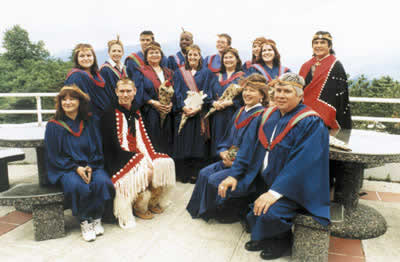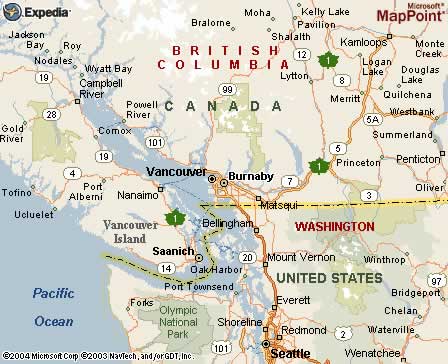|
|
Canku Ota |
|
|
(Many Paths) |
||
|
An Online Newsletter Celebrating Native America |
||
|
June 19, 2004 - Issue 115 |
||
|
|
||
|
Graduation Ceremony for First Nations Students |
||
|
by Matt Ross Indian Country Today |
||
|
credits: photo 1: First Nations graduates from Simon Fraser University’s Class of 2004.; photo 2:Taking the podium, Del Blaney thanked his family and faculty for their assistance with his efforts in achieving a B.A. in Anthropology and Archaeology. His future plans include applying for a master’s degree at the school’s faculty of Education. (Photos by Matt Ross) |
|
Seventeen students donned the hand-woven regalia, which represented achievement and completion as was appropriated to them from a Haida craftswoman. The director of the First Nations Student Centre (FNSC), Sasha Hobbs believes the importance of this regalia offered a symbolism to the event besides already receiving a degree. "We wanted to give the students something to take away as a memento of the day," Hobbs said. "While walking in two worlds, the students can keep their (Aboriginal) identity." Located on Burnaby Mountain, overlooking the city of Vancouver and Canada’s picturesque West Coast, Simon Fraser is in the country’s top-10 of university enrollments with 23,000 undergraduates. The main campus is on the historical lands of the Tsleil-Waututh, Squamish and Sto:lo nations. In addition to reflecting the ethnic diversity at the school, given the surrounding environment it’s natural, said Hobbs, to have a Native-only graduation. "We need to have a traditional First Nations ceremony because this is First Nations territory. That is protocol and we have a right to practice this," stated Hobbs. The affair on June 1 offered students the intimate opportunity of taking the microphone for whatever words they wanted to express. Most of the impromptu speeches were short, tending to give thanks for the assistance lent by family, friends and faculty.
"I’ve applied to continue with my education. I don’t know why but I’m hooked on learning," he remarked. Previously employed in the timber industry, Blaney switched directions to pursue academics at the age of 39 taking advantage of provincial retraining programs. Now 45, he said his degree offered times of stress and exhilaration but he anxiously looks forward to entering a master’s program at the Faculty of Education. With the goal of becoming a teacher back in his Sliammon Nation on B.C.’s Sunshine Coast north of Vancouver, Blaney also has ambitions of entering a school board’s administration. Citing high dropout rates among rural Aboriginal students, Blaney mentioned part of the problem of educational settings is they haven’t reflected the needs of First Nations. "The administrative position is to develop a curriculum in schools to help raise their pride and their true sense of worth within their community," Blaney said. Even with an all-Native graduation at SFU, the university too is on the receiving end of some stinging criticism. There are only 160 Aboriginal undergraduates, a proportion far less than the rest of British Columbia where First Nations comprise 5 percent of the population (most other post-secondary institutions in Canada also have a disproportionately low ratio of indigenous students). Regarded as a liberal cosmopolitan campus, even among other Canadian universities, Simon Fraser has previously acknowledged it has been slow to incorporate Natives into campus life and assist with their requirements. Most of the eight Aboriginal or Métis staff at SFU are employed at the FNSC while only three professors are of First Nations descent. Research coordinator at the FNSC, Rick Ouellet, in doling out praise for the professors and learning environment at the university, is highly critical of the school’s administration. Working on his master’s thesis in Archaeology that involves his Métis ancestral roots in Jasper (Alberta) National Park, Ouellet pointed out that even recent events at SFU display a cultural insensitivity. Earlier this spring a mural which was painted in the 1950s was erected that, as Ouellet bluntly said, was offensive. Displaying a European explorer, the Native Indians are depicted as bowing down to this white man. "It’s the result of B.C.’s need to deny its history because if it accepted the First Nations history, then it would have to admit that the resources belonged to the First Nations," Ouellet said. "Most of the province is still unsettled and so there is a need to perpetuate this myth." That’s where the First Nations Student Centre comes in. Developed in 1996 following a provincial report to increase access in post-secondary institutions for Aboriginal students, every public college and university in B.C. has an FNSC. Aimed at promoting Aboriginal initiatives, the center also consults with academic departments and serves as a community liaison. "We have become a place where people can go to find out about First Nations and to be connected (with other resources)," said Hobbs whose center hosted the graduation. |
|
|
www.expedia.com |
|
|
||
|
|
||
| Canku Ota is a free Newsletter celebrating Native America, its traditions and accomplishments . We do not provide subscriber or visitor names to anyone. Some articles presented in Canku Ota may contain copyright material. We have received appropriate permissions for republishing any articles. Material appearing here is distributed without profit or monetary gain to those who have expressed an interest. This is in accordance with Title 17 U.S.C. Section 107. | ||
|
Canku Ota is a copyright © 2000, 2001, 2002, 2003, 2004 of Vicki Barry and Paul Barry. |
||
 |
 |
|
|
The "Canku Ota - A Newsletter Celebrating Native America" web site and its design is the |
||
|
Copyright © 1999, 2000, 2001, 2002, 2003, 2004 of Paul C. Barry. |
||
|
All Rights Reserved. |
||
 BURNABY,
British Columbia - Eschewing the traditional mortarboard, graduates
at Simon Fraser University (SFU) wore a ceremonial cedar headband
during convocation specifically for Native Canadians.
BURNABY,
British Columbia - Eschewing the traditional mortarboard, graduates
at Simon Fraser University (SFU) wore a ceremonial cedar headband
during convocation specifically for Native Canadians. With
his B.A. in Archaeology and Anthropology, Del Blaney, in addition
to appreciating his wife’s support through five years, went
on to state his future goals.
With
his B.A. in Archaeology and Anthropology, Del Blaney, in addition
to appreciating his wife’s support through five years, went
on to state his future goals.